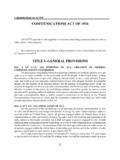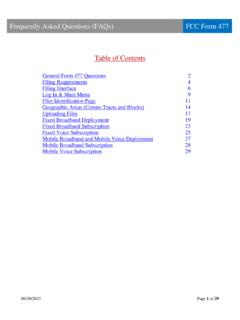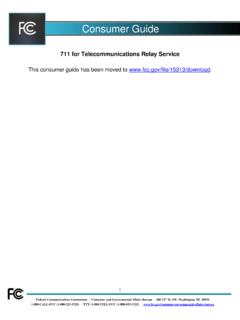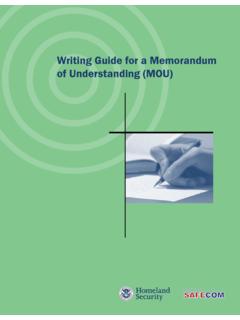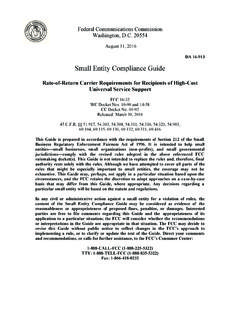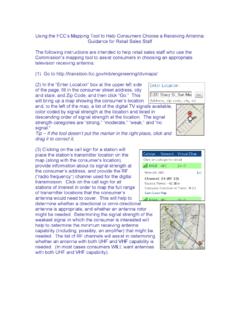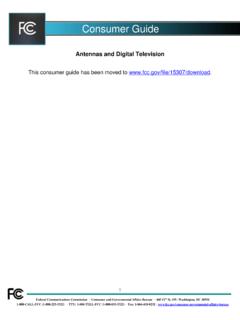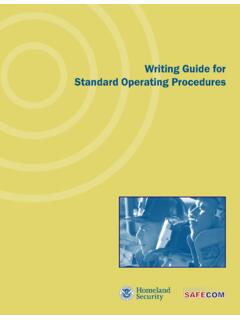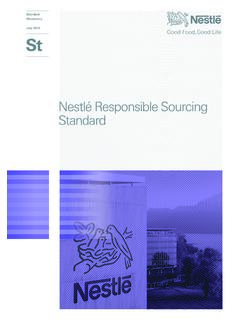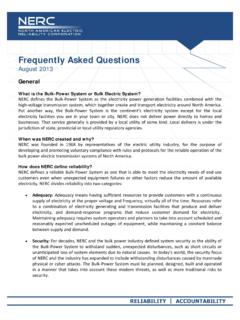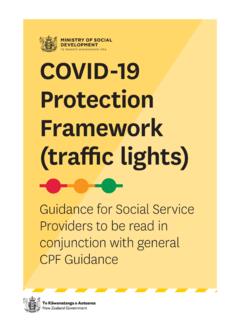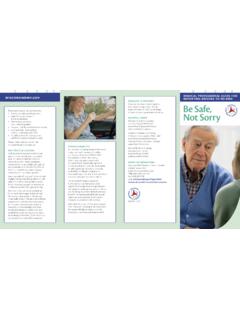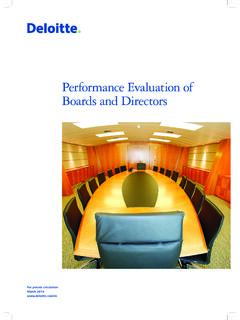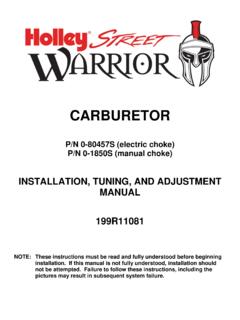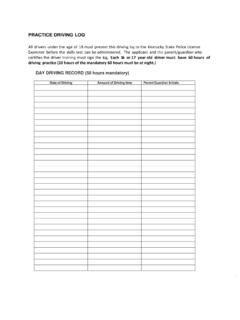Transcription of OET Bulletin 65 - Federal Communications Commission
1 Federal Communications Commission Office of Engineering & Technology_____Evaluating Compliance with FCCG uidelines for Human Exposure toRadiofrequency Electromagnetic FieldsOET Bulletin 65 Edition 97-01 August 1997 Evaluating Compliance with FCCG uidelines for Human Exposureto Radiofrequency Electromagnetic FieldsAUTHORSR obert F. Cleveland, M. SylvarJerry L. UlcekStandards Development BranchAllocations and Standards Division Office of Engineering and Technology Federal Communications Commission Washington, 20554 OET Bulletin 65 Edition 97-01 August 1997 The first edition of this Bulletin was issued as OST Bulletin No. 65 in October1985. This is a revised version of that original : Mention of commercial products does not constitute endorsement by the Federal CommunicationsCommission or by the following individuals and organizations from outside the FCC reviewed an early draft of thisbulletin.
2 Their valuable comments and suggestions greatly enhanced the accuracy and usefulnessof this document, and their assistance is gratefully A. Amato, Maxwell RF Radiation Safety, Aslan, Lockheed Martin Microwave (Narda)Ameritech Mobile Communications , Tadeusz M. Babij, Florida International UniversityDr. Quirano Balzano, Motorola David Baron, , Holaday Industries, I. Bassen, Food and Drug AdministrationClarence M. Beverage, Communications Technologies, Donald J. Bowen, AT&T LaboratoriesCellular Telecommunications Industry AssociationDr. Chou, City of Hope National Medical CenterJules Cohen, , Consulting EngineerDr. David L. Conover, National Institute for Occupational Safety & HealthCohen, Dippell and Everist, D.
3 Culver, Lohnes and CulverFred J. Dietrich, , GlobalstarElectromagnetic Energy AssociationProfessor Om P. Gandhi, University of UtahRobert Gonsett, Communications General & Edison, Hankin, Environmental Protection AgencyJames B. Hatfield, Hatfield & DawsonRobert JohnsonDr. John A. Leonowich Dr. W. Gregory Lotz, National Institute for Occupational Safety & HealthFrederick O. Maia, National Volunteer Examiners (Amateur Radio Service)Ed Mantiply, Environmental Protection AgencyRobert MooreDr. Daniel Murray, Okanagan University CollegeDr. John M. Osepchuk, Full Spectrum ConsultingProfessor Wayne Overbeck, California State University, FullertonPersonal Communications Industry AssociationRonald C.
4 Petersen, Lucent TechnologiesDavid B. PopkinKazimierz Siwiak, A. Tell, Richard Tell Associates, Van Tuyl, Hewlett-Packard LaboratoriesLouis A. Williams, Jr., Louis A. Williams, Jr. and AssociatesContributions from the following FCC staff members are also acknowledged: Kwok Chan, Errol Chang, William Cross, Richard Engelman, Bruce Franca and Jay JacksoniiTABLE OF CONTENTS 1 DEFINITIONS AND GLOSSARY OF 2 Section 1: BACKGROUND 6 FCC Implementation of 6 FCC Guidelines for Evaluating Exposure to RF 7 Applicability of New Guidelines .. 12 Mobile and Portable 14 Operations in the Amateur Radio Service .. 15 Section 2: PREDICTION 18 Equations for Predicting RF 19 Relative Gain and Main-Beam 22 Aperture 26 Special Antenna 30 Multiple-Transmitter Sites and Complex 32 Evaluating Mobile and Portable 40 Section 3: MEASURING RF 44 Reference 45 Field 49 Section 4: CONTROLLING EXPOSURE TO RF 52 Public Exposure: Compliance with General Population/Uncontrolled MPE 52 Occupational Exposure: Compliance with Occupational/Controlled MPE 60 APPENDIX A: RF Exposure Guidelines.
5 64 APPENDIX B: Summary of 1986 Mass Media Bureau Public Notice on RF Compliance .. 77 FIGURESFIGURE 1: Main-Beam Exposure (No Reflection) .. 24 FIGURE 2: Main-Beam Exposure (With Reflection) .. 25 FIGURE 3: Cassegrain Antenna .. 26 FIGURE 4: Single tower, co-located antennas, ground-level exposure (at 2 m) .. 38 FIGURE 5: Antennas on multiple towers contributing to RF field at point of interest .. 38 FIGURE 6: Single roof-top antenna, various exposure 39 FIGURE 7: Single tower, co-located antennas, on-tower 391 INTRODUCTIONThis revised OET Bulletin 65 has been prepared to provide assistance in determiningwhether proposed or existing transmitting facilities, operations or devices comply with limits forhuman exposure to radiofrequency (RF) fields adopted by the Federal CommunicationsCommission (FCC).
6 The Bulletin offers guidelines and suggestions for evaluating compliance. However, it is not intended to establish mandatory procedures, and other methods andprocedures may be acceptable if based on sound engineering practice. In 1996, the FCC adopted new guidelines and procedures for evaluating environmentaleffects of RF emissions. The new guidelines incorporate two tiers of exposure limits based onwhether exposure occurs in an occupational or "controlled" situation or whether the generalpopulation is exposed or exposure is in an "uncontrolled" situation. In addition to guidelines forevaluating fixed transmitters, the FCC adopted new limits for evaluating exposure from mobileand portable devices, such as cellular telephones and personal Communications devices.
7 TheFCC also revised its policy with respect to categorically excluding certain transmitters andservices from requirements for routine evaluation for compliance with the guidelines. This Bulletin is a revision of the FCC's OST Bulletin 65, originally issued in 1985. Although certain technical information in the original Bulletin is still valid, this revised versionupdates other information and provides additional guidance for evaluating compliance with thethe new FCC policies and guidelines. The Bulletin is organized into the following sections: Introduction, Definitions and Glossary, Background Information, Prediction Methods, MeasuringRF Fields, Controlling Exposure to RF Fields, References and Appendices.
8 Appendix Aprovides a summary of the new FCC guidelines and the requirements for routine evaluation. Additional information specifically for use in evaluating compliance for radio and televisionbroadcast stations is included in a supplement to this Bulletin (Supplement A). A supplement forthe Amateur Radio Service will also be issued (Supplement B), and future supplements may beissued to provide additional information for other services. This Bulletin and its supplementsmay be revised, as general, the information contained in this Bulletin is intended to enable an applicant tomake a reasonably quick determination as to whether a proposed or existing facility is incompliance with the limits.
9 In addition to calculations and the use of tables and figures, Section4, dealing with controlling exposure, should be consulted to ensure compliance, especially withrespect to occupational/controlled exposures. In some cases, such as multiple-emitter locations,measurements or a more detailed analysis may be required. In that regard, Section 3 onmeasuring RF fields provides basic information and references on measurement procedures further information on any of the topics discussed in this Bulletin , you may contactthe FCC's RF safety group at: +1 202 418-2464. Questions and inquiries can also be e-mailed to: The FCC's World Wide Web Site provides information on FCCdecision documents and bulletins relevant to the RF safety issue.
10 The address is: 2 DEFINITIONS AND GLOSSARY OF TERMSThe following specific words and terms are used in this Bulletin . These definitions areadapted from those included in the American National Standards Institute (ANSI) 1992 RFexposure standard [Reference 1], from NCRP Report No. 67 [Reference 19] and from the FCC'sRules (47 CFR and ). Average (temporal) power. The time-averaged rate of energy time. The appropriate time period over which exposure is averaged for purposes ofdetermining compliance with RF exposure limits (discussed in more detail in Section 1).Continuous exposure. Exposure for durations exceeding the corresponding averaging time.
